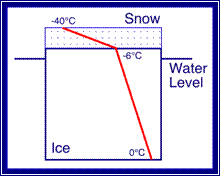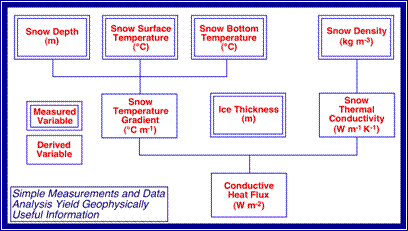Heat Flux Through the Snow Cover
Re-read the earlier section on Heat Transfer, paying particular attention to the information on latent heat.
Now we are going to examine how latent heat effects the formation of ice. And you (and your students) are going to learn how to measure the amount of heat that is transferred from the ground or the water (in a lake or pond), through the ice and snow, into the atmosphere.
Conductive heat flow, also known as heat flux, refers to the rate of the flow of heat from the ground or water into the atmosphere.
Why do we want to know the conductive heat flow (heat flux)?
Heat flux dominates the energy balance of the ice and snow and is the major source of heat transfer through floating ice and snow in winter. Consequently, it plays a role in weather and climate. Scientists study conductive heat flow primarily by studying sea ice. Less information is available on conductive heat flow through lakes.
The following facts help us understand heat flux through bodies of water.
- Water holds a tremendous amount of heat.
- That latent heat is released as water freezes and ice forms.
- As ice forms, the latent heat is conducted away from the water-ice interface to the atmosphere. In other words, heat moves from the water, through the ice, through the snow, into the air.
- As heat is conducted through water, ice, and snow into the atmosphere, it forms temperature gradients (variations in temperature) in the snow and ice (see figure below).
- Snow density is only one of the factors that determine how quickly heat can escape from bodies of water or the ground in winter.
- The rate at which the latent heat is conducted from the water to the atmosphere (heat flux), and thus the rate of ice growth and the thickness of the ice on bodies of water, is a function of: (a) snow depth, temperature and density; (b) ice thickness, temperature and density.

